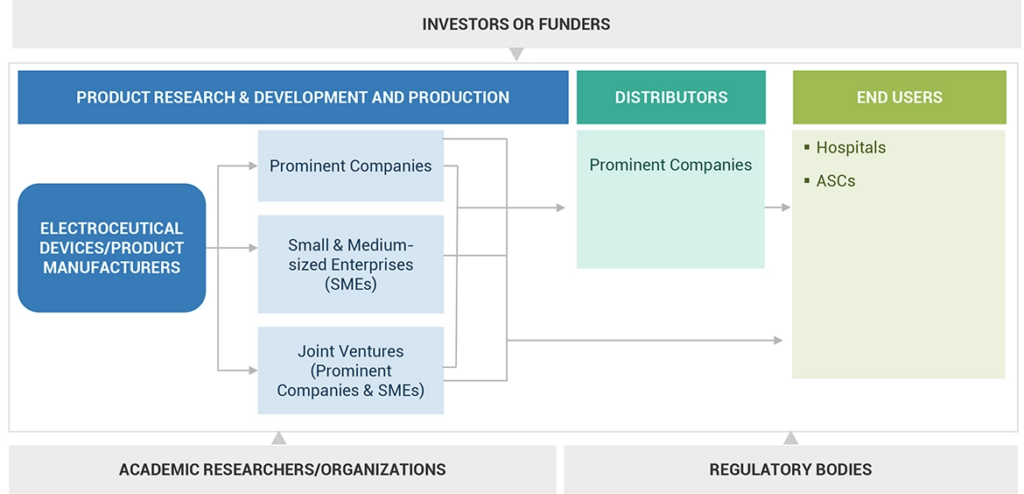The electroceuticals market, also known as the bioelectric medicine market, is experiencing significant growth, driven by advancements in medical technology and an increasing prevalence of chronic diseases. Electroceuticals are medical devices that utilize electrical stimulation to modulate neural activity, offering therapeutic benefits for various conditions. This article delves into the current trends, key players, and growth opportunities within this dynamic market.

Market Overview
As of 2024, the global electroceuticals market was valued at approximately $23.9 billion and is projected to reach $33.6 billion by 2029, growing at a compound annual growth rate (CAGR) of 7.0% during this period. This growth is largely attributed to the rising incidence of cardiovascular and neurological disorders, coupled with technological advancements in medical devices.
Key Market Segments
The electroceuticals market is segmented based on product types, including:
- Cardiac Pacemakers and Implantable Cardioverter Defibrillators (ICDs): These devices regulate heart rhythms and are essential in managing arrhythmias.
- Neuromodulation Devices: This category encompasses spinal cord stimulators, deep brain stimulators, vagus nerve stimulators, and sacral nerve stimulators, used to treat conditions like chronic pain, Parkinson’s disease, epilepsy, and depression.
- Cochlear Implants: Devices that provide a sense of sound to individuals with severe hearing loss.
- Retinal Implants: Emerging devices aimed at restoring vision for those with retinal degenerative conditions.
Among these, cardiac pacemakers and ICDs held the largest market share in 2022, primarily due to the increasing prevalence of cardiovascular disorders worldwide.
Leading Companies in the Electroceuticals Market
The market is highly competitive, with several key players driving innovation and expansion:
- Medtronic plc (Ireland): A global leader in medical technology, offering a wide range of electroceutical devices.
- Boston Scientific Corporation (USA): Known for its advanced neuromodulation and cardiac rhythm management devices.
- Abbott Laboratories (USA): Provides a diverse portfolio of medical devices, including cardiac pacemakers and neuromodulation products.
- LivaNova PLC (UK): Specializes in neuromodulation and cardiovascular solutions.
- Cochlear Ltd. (Australia): A leading provider of implantable hearing solutions.
These companies are at the forefront of developing innovative electroceutical therapies, investing heavily in research and development to enhance patient outcomes.
Market Drivers
Several factors are propelling the growth of the electroceuticals market:
- Aging Population: The global increase in the elderly population has led to a higher incidence of neurological and cardiovascular disorders, boosting demand for electroceutical devices.
- Technological Advancements: Continuous innovation in bioelectric medicine has resulted in more effective and minimally invasive devices.
- Rising Prevalence of Chronic Diseases: An increase in conditions such as Parkinson’s disease, epilepsy, and chronic pain has expanded the application of electroceutical therapies.
- Awareness and Acceptance: Growing awareness among healthcare professionals and patients about the benefits of electroceuticals has facilitated market expansion.
Challenges
Despite the positive outlook, the market faces certain challenges:
- High Costs: The development and implementation of electroceutical devices involve significant costs, which can be a barrier, especially in developing regions.
- Regulatory Hurdles: Stringent regulatory requirements can delay product approvals and market entry.
- Limited Reimbursement Policies: Inadequate insurance coverage for electroceutical treatments may hinder patient access.
Growth Opportunities
Emerging markets present substantial opportunities for growth:
- Asia-Pacific Region: Countries like India, China, and Japan are witnessing improvements in healthcare infrastructure and increased healthcare spending, making them attractive markets for electroceutical products.
- Product Innovation: Developing cost-effective and efficient devices can cater to the unmet needs in both developed and developing countries.
- Strategic Collaborations: Partnerships between medical device companies and research institutions can accelerate innovation and market penetration.
Conclusion
The electroceuticals market is poised for robust growth, driven by technological advancements and a rising prevalence of chronic diseases. Key industry players are continually innovating to address existing challenges and capitalize on emerging opportunities. Stakeholders should focus on strategic collaborations, investment in research and development, and expansion into emerging markets to maintain a competitive edge in this evolving landscape.